
The Phantom is an American adventure comic strip, first published by Lee Falk in February 1936. The main character, the Phantom, is a fictional costumed crime-fighter who operates from the fictional African country of Bangalla. The character has been adapted for television, film and video games.
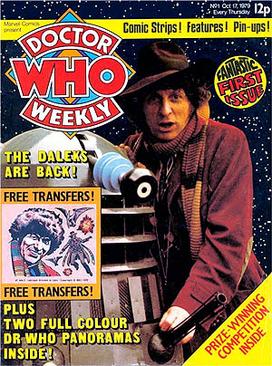
Doctor Who Magazine is a magazine devoted to the British science fiction television series Doctor Who. Launched in 1979 as Doctor Who Weekly, the magazine became a monthly publication the following year. With 13 issues a year, as well as producing triannual deluxe Special Editions (2002–) and Bookazines (2013–), the publication features behind the scenes articles on the TV show and other media, as well as producing its own comic strip. Its founding editor was Dez Skinn, and the longest-serving editor was Tom Spilsbury who served from 2007 to 2017. He was succeeded by Marcus Hearn, who took over from Spilsbury in July 2017. The incumbent editor is Jason Quinn, who took over from Hearn in September 2023. DWM is recognised by Guinness World Records as the longest running TV tie-in magazine, celebrating 40 years of continuous publication on 11 October 2019. The magazine published its 600th issue on 1 February 2024.

A British comic is a periodical published in the United Kingdom that contains comic strips. It is generally referred to as a comic or a comic magazine, and historically as a comic paper. As of 2014, the three longest-running comics of all time were all British.

Marvel UK was an imprint of Marvel Comics formed in 1972 to reprint US-produced stories for the British weekly comic market. Marvel UK later produced original material by British creators such as Alan Moore, John Wagner, Dave Gibbons, Steve Dillon, and Grant Morrison.
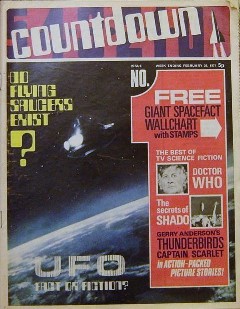
Countdown was a British comic published weekly by Polystyle Publications – ultimately, under several different titles – from early 1971 to late summer 1973. The pages in each issue were numbered in reverse order, with page 1 at the end – a gimmick which was derived from the comic's title in order to create a countdown to the number one every week.

Hulk Comic was a black-and-white Marvel UK comics anthology published under the editorship of Dez Skinn starting in 1979.
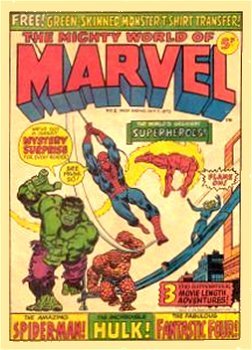
The Mighty World Of Marvel was a British comic book series published first by Marvel UK and then by Panini Comics. Debuting on 30 September 1972, it was the first title published by Marvel UK and ran until 1984. The series was revived in 2003 by Panini Comics, who are licensed to reprint Marvel US material in Europe, and was published monthly until November 2019.

Valiant was a weekly British comics periodical published by Fleetway Publications and later IPC Magazines from 4 October 1962 to 16 October 1976. A boys' adventure comic, it debuted numerous memorable characters, including Captain Hurricane, The Steel Claw and Mytek the Mighty. Valiant lasted for 712 issues before being merged with stablemate Battle Picture Weekly.
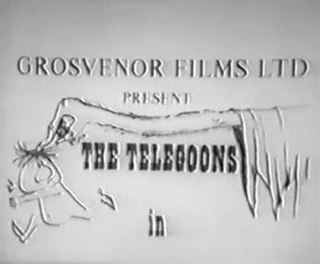
The Telegoons is a comedy puppet show, adapted from the highly esteemed and successful BBC radio comedy show of the 1950s, The Goon Show produced by Tony Young for BBC television and first shown during 1963 and 1964. Two series of 13 episodes were made. The series was briefly repeated immediately after its original run, and all episodes are known to have survived. Harry Secombe, Peter Sellers and Spike Milligan reprised their original voice roles from the radio series and appeared in promotional photos with some of the puppets from the series. Among the puppeteers were Ann Field, John Dudley, and Violet Phelan. The original radio scripts were adapted by Maurice Wiltshire, who had previously co-written a number of radio episodes with Larry Stephens.

TV Century 21, later renamed TV21, TV21 and Tornado, TV21 and Joe 90, and TV21 again, was a weekly British children's comic published by City Magazines during the latter half of the 1960s. Originally produced in partnership with Gerry and Sylvia Anderson's Century 21 Productions, it promoted the company's many science-fiction television series. The comic was published in the style of a newspaper of the future, with the front page usually dedicated to fictional news stories set in the worlds of Fireball XL5, Stingray, Thunderbirds, Captain Scarlet and the Mysterons and other stories. The front covers were also in colour, with photographs from one or more of the Anderson series or occasionally of the stars of the back-page feature.
This is a list of Dalek comic strips, illustrated annuals and graphic novels. Cameo appearances and reprints are only covered if notable.
Polystyle Publications Ltd was a British publisher of children's comics and books that operated from 1960 to 1997, publishing such titles as TV Comic, I-Spy, Pippin, Countdown/TV Action, and BEEB.
Roger Noel Cook was a British comics writer, musician, and magazine editor.
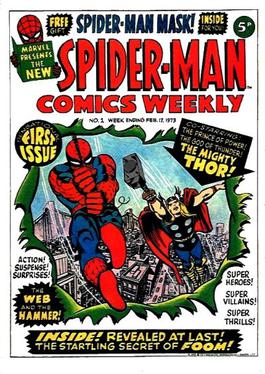
Spider-Man Comics Weekly was a Marvel UK publication which primarily published black-and-white reprints of American Marvel four-color Spider-Man stories. Marvel UK's second-ever title, Spider-Man Comics Weekly debuted in 1973, initially publishing "classic" 1960s Spider-Man stories.
First Doctor comic stories refers to the comic strips devoted to the long-running British science fiction television series Doctor Who, using the likeness of the First Doctor William Hartnell. The strip was launched in Polystyle's TV Comic on 14 November 1964, less than a year after the television series began broadcasting and was the first original spin-off media from the show. This strip began what has become known as the 'Polystyle era': running from 1964 to 1979. The First Doctor starred in this strip running parallel with his appearance on the television show, ending in December 1966, after which TV Comic began creating strips for the Second Doctor. The franchise to print a regular comic strip passed to Doctor Who Magazine in 1979, and was opened up to multiple franchises in the mid-2000s. During this time, the First Doctor has made various guest appearances as well as starring in some one-off comic strips.
Celebrity comics are comics based on the fame and popularity of a celebrity. They are a byproduct of merchandising around a certain media star or franchise and have existed since the mass media and comics came into existence in the 19th century. Celebrity comics are usually not held in high esteem by critics, because of their purely commercial nature. They are solely created to capitalize on media trends and therefore published so quickly and cheaply that drawings and narratives tend to be of very low quality.
The Doctor WhoPolystyle comic strip was the first comic strip devoted to the long-running British science fiction television series Doctor Who, and the first original spin-off media from the show. The strip was launched in TV Comic on 14 November 1964, less than a year after the television series began broadcasting. TV Comic was issued weekly, and one of a number of titles belonging to Polystyle Publications Ltd, the comic exclusively featuring strips based on television series.
City Magazines was a British publisher of weekly comics and men's magazines that operated from the mid-1950s to the mid-1970s. The company's most notable publications were comics magazines based on licensed television properties, including TV Century 21 and Lady Penelope, both of which featured comics based on Gerry Anderson's Century 21 Productions Supermarionation shows.
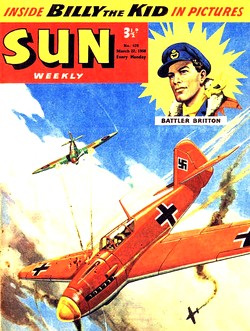
Sun was a weekly British comics periodical published by J. B. Allen, Amalgamated Press and Fleetway Publications between 11 November 1947 and 17 October 1959. During this time it was also known as Sun Comic, Sun Adventure Weekly, The Cowboy Sun Weekly, The Cowboy Sun, The Sun and Sun Weekly at various points, and ran for 551 issues before merging with Lion.












